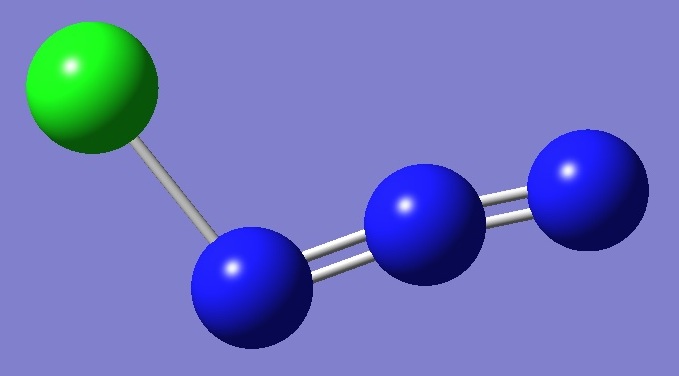|
|
|
|
|
|
|
|
|
|
|
|
|
|
|
|
|
|
|
|
|
ClN3
|
|
|
|
|

|
|
|
|
|
|
|
|
|
|
|
|
|
|
|
|
|
|
|
|
|
|
|
|
|
|
|
|
|
Chlorine
|
|
|
Nuclear
Quadrupole Coupling Constants |
|
|
|
in Chlorine Azide |
|
|
|
|
|
|
|
|
|
|
|
|
|
|
|
|
|
|
|
|
|
|
|
|
|
|
|
|
|
|
|
|
|
In Table 1, subscripts a,b,c refer to the principal axes of the inertia
tensor, subscripts x,y,z to the principal axes of the nqcc tensor.
The nqcc y-axis is chosen coincident with the inertia c-axis, these
are perpendicular to the plane of the molecule. Ø (degrees)
is the angle between its subscripted parameters. ETA = (Xxx
- Xyy)/Xzz. |
|
|
|
|
|
|
|
|
|
|
|
|
RMS is the root mean square
difference between calculated and experimental diagonal nqcc's (percent
of average experimental nqcc). RSD is the residual standard
deviation
of calibration of the B1LYP/TZV(3df,2p) model for calculation of
the Cl nqcc's. |
|
|
|
|
|
|
|
|
|
|
|
|
|
|
|
|
|
|
|
|
|
|
| |
|
|
|
|
|
|
|
|
Table 1. Chlorine
nqcc's in ClN3 (MHz). Calculation was made
on the ro structure of Cook and Gerry [1]. |
|
| |
|
|
|
|
|
|
|
|
|
|
|
Calc. |
|
Expt. [1] |
|
| |
|
|
|
|
|
|
|
|
35Cl |
Xaa |
|
- 55.68 |
- |
55.9 |
|
|
|
Xbb |
|
1.89 |
|
1.9 |
|
|
|
Xcc |
|
53.79 |
|
54.0 |
|
|
|
|Xab| |
|
75.95 |
|
|
|
|
|
|
|
|
|
|
|
|
|
RMS |
|
0.2 (0.5 %) |
|
|
|
|
|
RSD |
|
0.49 (1.1 %) |
|
|
|
|
|
|
|
|
|
|
|
|
|
Xxx |
|
54.32 |
|
|
|
|
|
Xyy |
|
53.79 |
|
|
|
|
|
Xzz |
- |
108.12 |
|
|
|
|
|
ETA |
- |
0.0050 |
|
|
|
|
|
Øz,a |
|
34.62 |
|
|
|
|
|
Øa,ClN |
|
36.23 |
|
|
|
|
|
Øz,ClN |
|
1.61 |
|
|
|
|
|
|
|
|
|
|
|
|
37Cl |
Xaa |
|
- 44.37 |
- |
44.4 |
|
|
|
Xbb |
|
1.97 |
|
1.8 |
|
|
|
Xcc |
|
42.39 |
|
42.6 |
|
|
|
|Xab| |
|
59.67 |
|
|
|
|
|
|
|
|
|
|
|
|
|
RMS |
|
0.2 (0.5 %) |
|
|
|
|
|
RSD |
|
0.44 (1.1 %) |
|
|
|
|
|
|
|
|
|
|
|
|
|
| |
|
|
|
|
|
|
|
|
|
|
| |
|
|
|
|
| Table 2. ClN(1)N(2)N(3). Molecular structure parameters, ro [1] (Å and degrees). |
| |
|
|
|
|
|
|
|
ClN |
1.745 |
| Z-Matrix |
N(1)N(2) |
1.252 |
|
|
|
N(2)N(3) |
1.133 |
|
|
|
ClNN |
108.67 |
|
|
|
NNN |
171.93 |
|
|
|
|
|
|
|
|
|
|
|
|
|
|
|
|
|
|
|
|
|
|
|
[1] R.L.Cook and M.C.L.Gerry, J.Chem.Phys. 53,2525(1970).
|
|
|
|
|
|
|
|
|
|
|
|
|
|
|
|
|
|
|
|
|
|
|
NH2Cl |
NCl3 |
CH3N3 |
HN3 |
|
|
|
|
|
|
|
|
|
|
|
|
|
|
|
|
|
|
|
|
|
|
Table of Contents |
|
|
|
|
|
Molecules/Chlorine |
|
|
|
|
|
|
|
|
|
|
|
|
|
|
|
|
|
|
|
|
|
|
|
|
|
|
|
|
|
|
ClN3.html |
|
|
|
|
|
|
Last
Modified 5 June 2003 |
|
|
|
|
|
|
|
|
|
|
